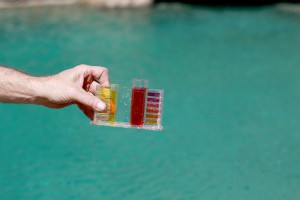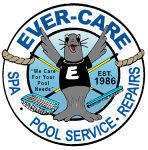 Using pool chemicals or hot tub chemicals is essential when trying to perform chemistry maintenance. Not only do these chemicals help ensure that your pool runs the way it should, but it also can help kill any algae or bacteria that might be growing. While most people know the importance of chemistry maintenance, they aren’t really sure what the different chemicals do or why certain ones work better than others. Here’s our advice for keeping your pool or hot tub running right.
Using pool chemicals or hot tub chemicals is essential when trying to perform chemistry maintenance. Not only do these chemicals help ensure that your pool runs the way it should, but it also can help kill any algae or bacteria that might be growing. While most people know the importance of chemistry maintenance, they aren’t really sure what the different chemicals do or why certain ones work better than others. Here’s our advice for keeping your pool or hot tub running right.
Why Is Chemistry Maintenance So Important?
The reason why chemistry maintenance is so important is that it’s what keeps your pool clean and working correctly. Every time someone gets into your pool or hot tub, he or she leaves behind things like oils, dead skin and leftover residue from shampoo or soaps. Add into that the environmental dirt that can accumulate, making treating your water is essential. If you were to just leave your water alone and not treat it, all of these things are going to build up and make it even harder to clean down the road. There’s even a chance that you’ll have to completely drain and refill the pool if it gets too bad.
What Do You Want to Control Through Chemicals?
It’s also important to know what these chemicals control. In addition to killing things like microbes and algae, pool chemicals and hot tub chemicals can also be helpful in making sure the water is actually disinfected. This is especially important if you have a lot of people swimming in a short amount of time. Other chemicals are also added to control things like pH, alkalinity and hardness. All of these things can cause their own issues, so it’s important to get them balanced as soon as possible.
Chemical Factors to Know
Now, we’re going to actually look at some of the factors that go into making sure your pool or hot tub is working correctly and safely. These things are what chemicals are used to treat and we’ll look at why this is important. Keep in mind, some of these things aren’t as important as others, but all of them should be treated just the same.
pH
One of the first things people worry about when balancing their pool is the pH. The pH is the balance between acid and alkaline in the water. Most pools need to be at around 7.4. Not only is this the same pH as human eyes and mucous membranes, but it’s also the perfect number for chlorine disinfection. Anything above that number is high, and anything below is low.
Alkalinity
The next thing to look for when balancing your pool or hot tub is the alkalinity. This measurement indicates the number of alkaline substances in the pool. The bicarbonate alkalinity is what chemicals regulate in a pool or hot tub, and it should be between 80 and 120 parts per million. Anything lower than 80 should be increased, and anything higher than 120 should be decreased.
Calcium Hardness
You’ll also want to pay attention to what the calcium hardness level is. Calcium hardness is just a measure of how soft or hard your water is and the amount of the calcium that dissolves in the water. For the most part, you want the calcium levels in your water to be between 200 and 400 parts per million. While calcium levels don’t need to be checked as often as things like pH or alkalinity, it should be checked every one to two weeks.
What Does Low Calcium Hardness Do?
Low calcium hardness can cause a few issues. The most common is long-term damage to things like plaster, vinyl, grout and metal railings. The reason it does this is because the water is trying to leech any calcium it can from these things. Low calcium can really shorten the life of these things and cause you to spend more money, in the long run, getting everything replaced.
How to Raise Calcium Hardness
Since you now know what happens when the hardness isn’t high enough, it’s important to understand what can be done to raise the levels. The good news is that raising the levels are a lot easier to do than lowering them. All you have to do is add some kind of calcium hardness increaser to the water. Make sure you follow the directions and test your water after adding the solution to ensure it’s at the levels it needs to be.
What Does High Calcium Hardness Do?
On the other hand, you don’t want the calcium to be too high. Water that has a high level of calcium can lead to your pool water being cloudy. When this happens, it can be hard to clear it regardless of the number of times you shock it. There’s also a chance that you’ll have to completely drain and refill it. Having high calcium can also cause sediments to build up on the sides of your pool or even the various plumbing parts.
How to Lower the Calcium Hardness
It’s a little harder to get the calcium levels lower than it is to make them higher. The good news is that it’s possible. For starters, you can drain some of the water and refill it if you have soft water. You could also add chemicals to attract extra calcium and cause them to clump. You can then skim them out. Finally, if none of those work, you can try adding dry acid to help lower the levels. If all else fails, you might have to do a full drain and refill.
What to Know About Sanitizing Chemicals
It’s also important to know what pool chemicals and hot tub chemicals are used the most. For the most part, every hot tub or pool will be treated with these chemicals and each one is used for something different. With that said, we’re going to talk about what the chemicals actually are and what their exact purpose is.
Chlorine
Chlorine is one of the most commonly used chemicals to help balance and sanitize your pool. It can help kill bacteria that are growing as well as other things like algae. Once you pour the chlorine in, it actually breaks down into different chemicals that work together to balance and kill everything. While it’s relatively safe, having too much in your pool can cause some reactions, such as burning eyes.
Biguanide
Biguanide is a chemical that is mainly used to disinfect pools. It’s started to become pretty popular in the last few years because it has virtually no effect on swimmers. One thing to keep in mind is that there aren’t any regulations on using biguanide in a personal or residential pool, but it isn’t allowed to be used in commercial pools in a lot of places.
Bromine
Bromine is a chemical that’s commonly used in place of chlorine. It helps disinfect the water and kills any bacteria or algae that’s growing. The reason some people use this instead of chlorine is because it tends to tolerate the heat quite a bit better. It’s very similar to chlorine and causes a similar reaction, but the makeup of it is a little bit different.
Minerals
Minerals for pool or hot tub water can be used to help disinfect and kill bacteria or algae. Using these chemicals can actually reduce the need for chlorine quite a bit. Many times, multiple chemicals are combined to work together in order to make sure everything is balanced and disinfected. The exact chemicals included will vary from product to product, but most of them will include magnesium chloride, sodium chloride and potassium chloride.
Ozone
While it’s not as common as the others, ozone is a chemical that has been used quite a bit. Not only can it give the water a better smell, but it can also help with clarity. It can be used to dissolve various types of metals and remove things like soaps, scum, oils and chloramines that can build up in your pool or hot tub water.
Do I Need to Shock My Pool?
While some pools don’t need to be shocked, others do. It’s really going to depend on what kind of condition your pool and water is in. If everything is fine and balanced, then it probably doesn’t need to be shocked. On the other hand, if it isn’t balanced, and there are things like algae growing, you should go ahead and shock it. Keep in mind that shocking a pool that doesn’t need it can throw off the balance of everything else, which will lead to more chemicals needing to be added.
How to Recognize Algae
It’s important to recognize any algae that grow in your pool. The most common are green, yellow and black. While other types can grow, these are the ones that most people will see. Since each of these kinds of algae presents their own risks, you should know how to identify them and what can happen if you let them grow. The following is a look at what can be done to ensure they are killed and completely removed.
Green
Green is one of the most common types of algae found in pools and hot tubs. The good news is that it’s the easiest to kill and isn’t as dangerous or risky as other types. Oftentimes, this type of algae will turn all of the water green. It could also turn the walls of your pool or hot tub green. The easiest way to kill this type of algae is to chlorinate and shock your water.
Yellow
Yellow algae are also known as brown or mustard algae. This type usually looks like sand or pollen and commonly grows in the shady corners of your pool or hot tub. This type is rare, and it’s not slimy the same way green algae is. While yellow algae are chlorine resistant, they can be removed by brushing and vacuuming them out. Once you do that, balance your pool, and add the required chemicals.
Black
Black algae are technically cyanobacterium and a very nasty substance. They make their own food, which lets them continue to grow. The roots will also dig into concrete, which makes it even harder to kill. The easiest way to kill black algae is by doing a lot of brushing and scrubbing. You also want to clean your filter, balance everything and shock it at least four times. You might have to do everything more than just a few times in order to really get rid of the algae.
As you can see, pool chemicals and hot tub chemicals are pretty essential when performing chemistry maintenance in order to keep your hot tub or pool clean and working correctly. Every chemical has a certain job to do, and they all work together to ensure that your water stays clean and balanced. It’s important to be familiar with each of the chemicals and what their jobs are in order to find the best combination for your particular pool or hot tub. After a little bit of experimenting, you should be able to create the perfect chemistry maintenance schedule for your needs.


